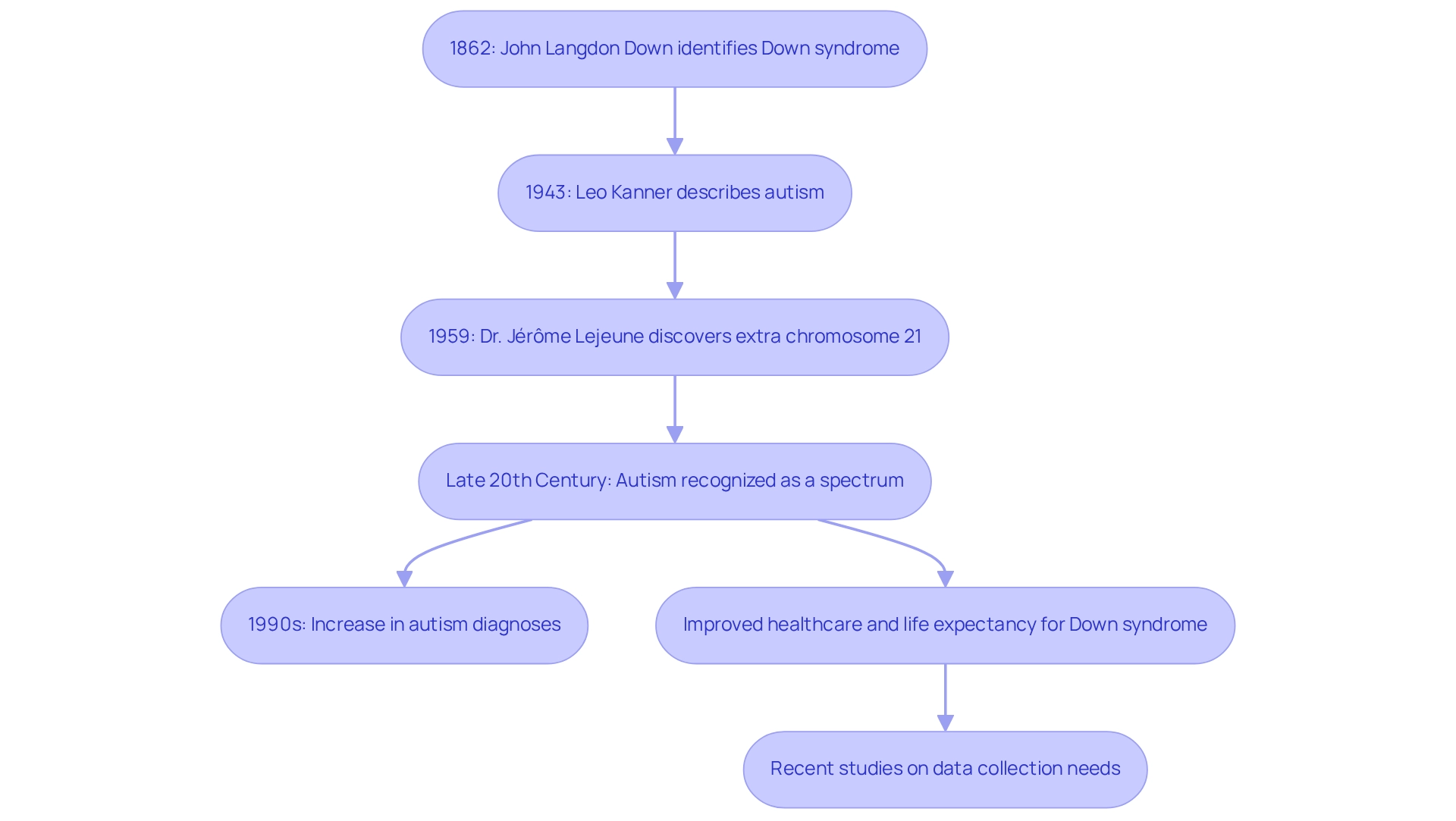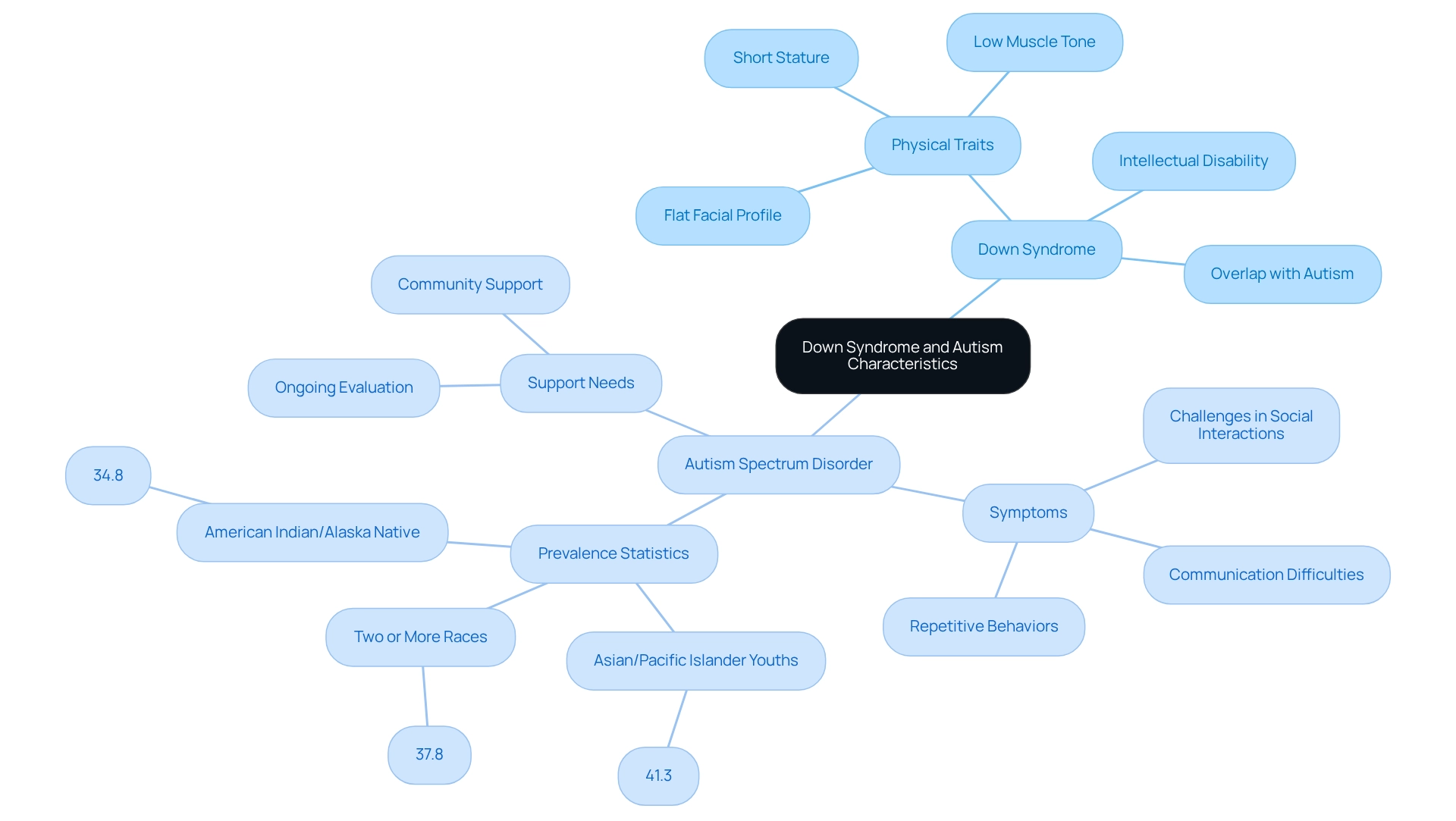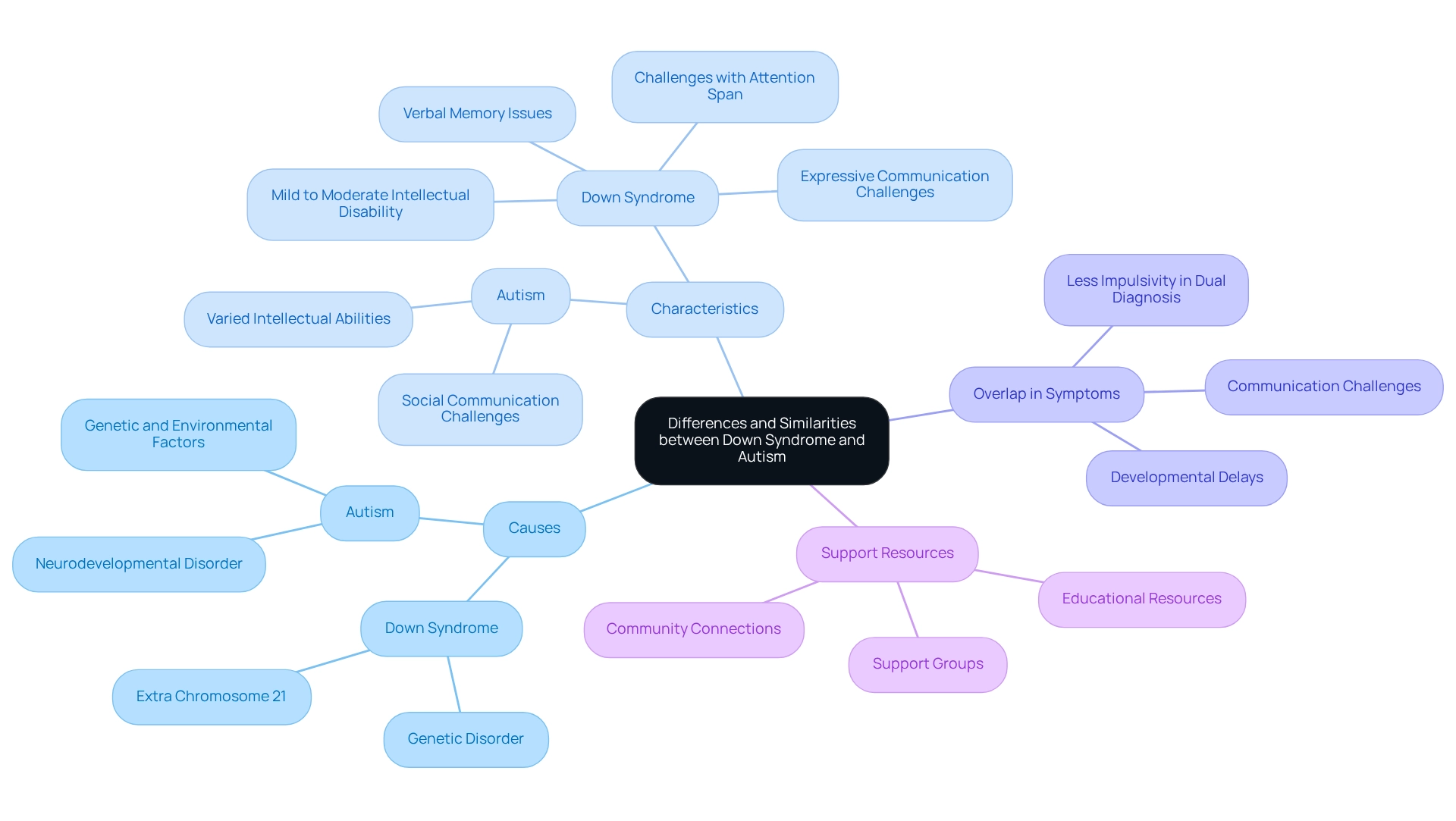Overview
Understanding the differences between Down syndrome and autism spectrum disorder (ASD) is essential for parents navigating these unique challenges. Down syndrome is a distinct genetic disorder, marked by the presence of an extra chromosome 21. In contrast, autism spectrum disorder is a neurodevelopmental disorder with its own origins and symptoms. While there may be some overlap in symptoms, such as developmental delays, it’s crucial to recognize that these two conditions require tailored support strategies.
Imagine a parent trying to find the right resources for their child. They may notice similar developmental delays in both conditions, yet the underlying causes and characteristics are different. This distinction is vital for ensuring that each child receives the appropriate support they need to thrive.
As you explore the needs of children with Down syndrome and ASD, remember that understanding these differences can lead to more effective strategies for support. By fostering a compassionate approach and seeking out specific resources, we can help ensure that every child has the opportunity to reach their full potential. If you have experiences or insights to share, we encourage you to connect with us in the comments or through our newsletter. Your voice matters in this community.
Introduction
In the realm of developmental disorders, Down syndrome and Autism Spectrum Disorder (ASD) represent two distinct yet often misunderstood conditions. Both can impact an individual's development, but their origins, symptoms, and implications for support vary significantly.
- Down syndrome, a genetic condition characterized by an extra chromosome 21, presents unique physical traits and developmental challenges that families often navigate with care and support.
- Conversely, ASD is a neurodevelopmental disorder marked by difficulties in social communication and restricted interests, which can create unique challenges for individuals and their loved ones.
As awareness grows, so does the need to differentiate between these conditions. It is essential to understand that some individuals may experience both, which can further complicate their developmental journey.
This article delves into the definitions, historical context, characteristics, and misconceptions surrounding Down syndrome and autism. Our aim is to illuminate the complexities of these conditions and highlight the importance of tailored support for those affected. We invite you to join us in exploring these topics, sharing insights, and fostering a compassionate community for all families impacted by these developmental disorders.
Define Down Syndrome and Autism Spectrum Disorder
Down condition is a genetic issue that arises from the presence of an additional copy of chromosome 21. This condition leads to developmental delays and distinct physical traits, such as a flattened face and almond-shaped eyes. In about 2% of cases, mosaic Down condition occurs, where not all cells contain this extra chromosome.
On the other hand, Autism Spectrum Disorder (ASD) is a neurodevelopmental disorder characterized by challenges in social communication, restricted interests, and repetitive behaviors. While both conditions affect development, they originate from different biological mechanisms and present unique symptoms; recent studies have sparked discussions on whether Down syndrome is a type of autism, highlighting that advancements in healthcare have enabled many individuals with Down syndrome to live into their 60s and beyond. This underscores the importance of understanding both conditions in the context of lifelong support and development.
At the time of diagnosis, numerous testing firms and medical practices provide the Prenatal and Newborn Information on Down condition pamphlet, which offers essential resources for parents.
Statistics reveal that ASD affects approximately 1 in 36 children, emphasizing the urgent need for awareness and resources tailored to these distinct yet sometimes overlapping conditions. As Dr. Ananya Mandal notes, health communication is about making medical knowledge understandable and accessible to everyone. This accessibility is crucial for advocates and families navigating the complexities of these challenges. Together, let us foster a supportive community where knowledge and compassion thrive.

Explore the Origins and Historical Context of Down Syndrome and Autism
The journey of understanding Down condition began with British physician John Langdon Down in 1862, who identified its distinctive physical traits. Fast forward to 1959, when Dr. Jérôme Lejeune shed light on the genetic basis of the condition by discovering an extra chromosome 21. In contrast, autism was first described by Leo Kanner in 1943 and was once seen as a rare disorder. However, the late 20th century marked a pivotal shift, as awareness grew and autism began to be recognized as a spectrum of disorders.
Since the 1990s, historical statistics reveal a dramatic increase in the diagnosis of autism spectrum disorder (ASD), reflecting advancements in diagnostic criteria and heightened public awareness. Similarly, the occurrence of Down's condition has also seen changes, influenced by improved healthcare and increased life expectancy, resulting in a rise in diagnoses. Recent studies emphasize the urgent need for enhanced data collection methods to accurately reflect the demographics and health outcomes of individuals with Down's condition. This highlights the ongoing necessity for advocacy and research.
As Dr. Heidi Moawad, a neurologist and brain health expert, notes, 'Due to the health effects and the risk of earlier-than-average age of death, Down condition is more prevalent among children than adults, and the occurrence diminishes with age.' Furthermore, the increase in fatalities among individuals with Down's condition since the 1990s, likely linked to the stabilization of life expectancy growth, underscores the importance of understanding health outcomes.
The case study titled 'Data Limitations in Down Condition Research' illustrates the challenges in accurately estimating the prevalence and population size of individuals with Down condition, emphasizing the need for improved data collection methods. This historical context serves as a reminder of the significance of ongoing efforts to comprehend and support individuals with both conditions, fostering a more inclusive community. Together, we can advocate for better resources and understanding, ensuring that every individual is valued and supported.

Identify Key Characteristics and Symptoms of Down Syndrome and Autism
Individuals with Down syndrome often possess distinct physical traits, such as a flat facial profile, short stature, and low muscle tone, which can accompany varying degrees of intellectual disability. In contrast, autism spectrum disorder (ASD) presents a diverse array of symptoms, including challenges in social interactions, communication difficulties, and repetitive behaviors. While there is notable overlap—some individuals with Down syndrome may also be diagnosed with autism—it is essential to clarify that Down syndrome is not a type of autism, as these two conditions exhibit significant differences in behavioral patterns and cognitive abilities.
Recent studies reveal that the prevalence of ASD among youngsters with intellectual disabilities varies. For instance, notable statistics indicate that:
- 41.3% of Asian/Pacific Islander youths
- 37.8% of individuals from two or more races
- 34.8% of American Indian/Alaska Native individuals
fall within this category. This underscores the necessity for precise data collection to better understand the complexities of ASD. As Isabel Ricke insightfully noted, "Community partners at clinical and educational data sources shared data that enabled the generation of these estimates."
Moreover, case studies, such as the identification of 713 individuals with ASD in Tennessee, highlight that:
- 79.1% had an ASD ICD code
- 59.5% classified for special education
This emphasizes the critical need for ongoing evaluation and support for impacted youth. The ADDM Network's active surveillance approach allows for detailed reporting on when and where children are identified with ASD, further highlighting the importance of accurate data collection.
Developmental psychologists emphasize that although signs of Down syndrome and autism may coincide, the cognitive profiles frequently vary, prompting the inquiry: is Down syndrome a type of autism? This variance necessitates customized strategies for assistance and intervention, ensuring that every child receives the support they need to thrive. If you are navigating these challenges, consider reaching out to local support groups or educational resources that can provide guidance and community support.

Clarify Misconceptions: Differences and Similarities Between Down Syndrome and Autism
A common misunderstanding is whether Down syndrome is a type of autism; however, they represent distinct diagnoses, each with unique causes and characteristics. Down syndrome is primarily a genetic disorder caused by an extra chromosome 21, while autism is a neurodevelopmental disorder shaped by a blend of genetic and environmental factors.
It's important to note that studies indicate around 16-20% of individuals with Down syndrome may also receive an autism diagnosis, raising the question: is Down syndrome a type of autism? This dual diagnosis can result in overlapping symptoms, such as developmental delays and communication challenges, necessitating tailored support strategies to address the specific needs of each individual.
Moreover, students with both Autism Spectrum Disorder (ASD) and Down syndrome often exhibit less impulsivity compared to those with a single diagnosis of ASD, leading to the inquiry: is Down syndrome a type of autism? Yadira Estrada, MSW Intern, shares that 'Individuals with Down syndrome often have mild to moderate intellectual disability and may face particular challenges with attention span, verbal memory, and expressive communication.' Understanding these differences is vital for parents and professionals alike, as it enables them to provide effective interventions and cultivate an inclusive environment.
Additionally, resources available for families of individuals with both Down syndrome and autism can offer essential support and information. These resources empower families to navigate the complexities of dual diagnoses, fostering a sense of community and understanding. If you or someone you know is facing these challenges, consider reaching out for support and sharing your experiences. Together, we can create a more inclusive world for everyone.

Conclusion
Understanding the distinctions between Down syndrome and Autism Spectrum Disorder (ASD) is crucial for fostering awareness and support for individuals and families affected by these conditions. Down syndrome, a genetic disorder characterized by an extra chromosome 21, presents unique physical traits and developmental challenges. In contrast, ASD is a neurodevelopmental disorder marked by difficulties in social communication and restricted interests. While there may be some overlap—where individuals with Down syndrome may also receive an autism diagnosis—the two conditions originate from different biological mechanisms and require tailored approaches to support.
Historically, both conditions have evolved in terms of recognition and understanding. Down syndrome was first characterized in the 19th century, while autism gained attention in the mid-20th century. The increasing prevalence of both conditions highlights the need for ongoing research and advocacy, particularly as improvements in healthcare have led to longer life expectancies for individuals with Down syndrome. Furthermore, the complexities of ASD necessitate precise data collection to better comprehend its impact and to develop effective interventions.
Ultimately, dispelling misconceptions surrounding Down syndrome and autism is essential for promoting inclusivity and support. Recognizing that these are distinct diagnoses with unique characteristics allows for more effective communication and intervention strategies. By fostering a compassionate community and providing tailored resources, families can navigate the challenges associated with these developmental disorders, ensuring that individuals receive the understanding and support they need to thrive.
Frequently Asked Questions
What is Down syndrome?
Down syndrome is a genetic condition caused by the presence of an additional copy of chromosome 21, leading to developmental delays and distinct physical traits such as a flattened face and almond-shaped eyes.
What is mosaic Down syndrome?
Mosaic Down syndrome occurs in about 2% of cases, where not all cells in the individual contain the extra chromosome 21.
What is Autism Spectrum Disorder (ASD)?
Autism Spectrum Disorder (ASD) is a neurodevelopmental disorder characterized by challenges in social communication, restricted interests, and repetitive behaviors.
How do Down syndrome and ASD differ?
While both conditions affect development, they originate from different biological mechanisms and present unique symptoms.
Is there a connection between Down syndrome and autism?
Recent studies have sparked discussions on whether Down syndrome is a type of autism, but they are distinct conditions with different characteristics.
What resources are available for parents regarding Down syndrome?
At the time of diagnosis, numerous testing firms and medical practices provide the Prenatal and Newborn Information on Down syndrome pamphlet, which offers essential resources for parents.
How common is Autism Spectrum Disorder?
Statistics indicate that Autism Spectrum Disorder affects approximately 1 in 36 children.
Why is health communication important for families dealing with these conditions?
Health communication makes medical knowledge understandable and accessible, which is crucial for advocates and families navigating the complexities of Down syndrome and autism.
What is the significance of advancements in healthcare for individuals with Down syndrome?
Advancements in healthcare have enabled many individuals with Down syndrome to live into their 60s and beyond, highlighting the importance of lifelong support and development.




